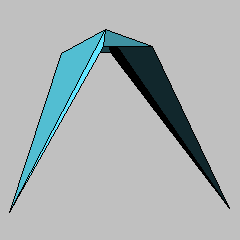

 |
Unlike smooth minimal surfaces, discrete minimal surfaces might not lie in the convex hulls of their boundaries [1]. This example is a simple case of such a surface, and thereby disproves existence of a discrete version of the maximum principle for discrete minimal surfaces. We define discrete minimal surfaces as piecewise linear continuous triangulated surfaces that are critical for the area functional with respect to all variations through surfaces of the same type that preserve the simplicial structure.
The maximum principle for solutions of elliptic partial differential equations says, that if two solutions are tangent at a common point and one solution lies on one side of the other solution then both solutions are identical [6][7]. This maximum principle does not hold for discrete minimal surfaces as the following example demonstrates [1]: the central vertex lies outside the convex hull of its boundary, therefore, any xy-planar triangulation, which is certainly discrete minimal, lies one side of the example. For example, consider the planar triangulation obtained from projecting the surface onto the xy-plane. This planar projection is combinatorically equivalent. Further, the surface even is a minimal graph over the planar minimal projection.
A discrete surface in Euclidean 3-space is a triangular mesh T which has the topology of an abstract 2-dimensional simplicial surface K combined with a geometric continuous realization in Euclidean 3-space that is piecewise linear on each simplex. The geometric realization |K| is determined by a set of vertices V in Euclidean 3-space, and T can be identified with the pair (K,V). The simplicial complex K represents the connectivity of the mesh. The 0, 1, and 2 dimensional simplices of K represent the vertices, edges, and triangles of the discrete surface.
The area of a discrete surface T is the sum of the Euclidean areas of the triangles in T.
Consider variations in the set of discrete surfaces defined by varying the vertices: Let Vi be the set of interior vertices of a discrete surface T. A boundary-preserving variation T(t) of T is defined as a C2 variation in t of the vertices in Vi so that the vertices comprise the set Vi when t=0. The straightness of the edges and the flatness of the triangles are preserved as the vertices move.
We say that a discrete surface T is minimal if T is critical for area with respect to all boundary-preserving variations T(t) [2].
This is analogous to the definition of smooth minimal surfaces. In the case of compact smooth minimal surfaces, the maximum principle of elliptic equations ensures that such smooth surfaces are contained in the convex hulls of their boundaries [7].
However, this is not the case for discrete minimal surfaces. Consider the discrete minimal surface shown here. For some height directions, this surface's height functions have strict local maxima at the single interior vertex. Hence this example does not lie in the convex hull of its boundary and thereby disproves the general existence of a discrete version of the maximum principle.
This example is a special configuration of the 1-parameter family of discrete minimal surfaces:
<points> <pf>-u 0. -u </pf> <pf> u 0. -u </pf> <pf>-1. 1. 0.</pf> <pf> 1. 1. 0.</pf> <pf>-1. -1. 0.</pf> <pf> 1. -1. 0.</pf> <pf> 0. 0. h(u)</pf> </points> <faces> <f>0 6 2</f> <f>6 3 2</f> <f>6 1 3</f> <f>0 4 6</f> <f>4 5 6</f> <f>5 1 6</f> </faces>The parameter
u varies in (0,infinity) and the function h(u) determines
the vertical height of the center vertex. For u in [0,2] the central
vertex lies within the convex hull of the boundary after minimization. The remarkable
fact is that this property does not hold for u > 2 when the minimum
position of the central vertex is outside the convex hull of the boundary.
This model corresponds to the parameter value u = 5. Note, there exists a
JavaView applet [4] which is available on the page PaMaxPrinciple.html
referenced below.
Note, since the identity map of a discrete minimal surface is a discrete
harmonic map, this example also demonstrates that the mean value property and
convex hull property of discrete harmonic maps do not hold [2].
Further note, that both properties hold in special situations where either all
triangles are equilateral or have all vertex angles in [-90,90] degrees. In this
example, the center vertex lies on the convex hull exactly at u = 2
which is the situation when the first vertex angle becomes 90 degrees. Increasing
u further leads to an increasing angle. To better understand the
influence of the vertex angles have a look at the paper Pinkall/Polthier [2] with
an explicit formula of the balancing formula for discrete minimal surfaces.
Note, that the discrete maximum principle does hold for the five-vertex laplacian defined over a the special rectangular ZxZ grid. [5]
Model produced with: JavaView v.2.00.a12
| Keywords | Minimal Surface; Discrete Surface; Maximum Principle | |
| MSC-2000 Classification | 53-04 (53-XX, 68Uxx, 68Rxx, 65Kxx, 65M50) | |
| Zentralblatt No. | 01683030 |
Submitted: Thu Nov 30 12:50:27 CET 2000.
Revised: Fri Jun 29 21:26:10 CET 2001.
Accepted: Fri Jul 20 09:46:58 CET 2001.
Technische Universität BerlinWayne Rossman
Fachbereich Mathematik
Straße des 17. Juni 136
10623 Berlin
Germany
polthier@math.tu-berlin.de
http://www-sfb288.math.tu-berlin.de/~konrad
Kobe University
Mathematics Department
Faculty of Science
Rokko, Kobe 657-8501
Japan
wayne@math.sci.kobe-u.ac.jp
http://www.math.kobe-u.ac.jp/HOME/wayne/wayne.html